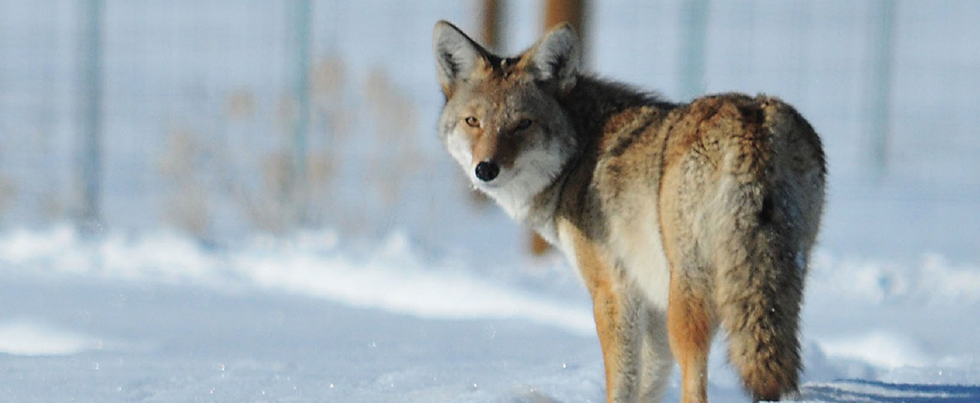
Wild Animals
Rocky Ridge and Royal Oak, thanks to its wetland areas and location on the city’s edge, attracts wildlife to our area. Seeing these creatures so close to our urban environment is an honour.
With the recent wildlife sightings in our community, here’s just a quick reminder on what animals you may see and how to deal with any sightings.
Material taken from the City of Calgary’s website as well as Alberta Fish and Wildlife. For your safety and the animal’s well being, please maintain a safe distance between yourself and any animal encountered. Do not provoke animals and remember, never feed any wildlife.
Coyotes
Coyotes are common in Calgary, including Rocky Ridge and Royal Oak. Keep your dog leashed at all times, your cat inside as much as possible (especially at night) and pick up children or small dogs if a coyote is spotted. If you are in a remote location and spot a coyote, leave the area immediately.
Never leave food in your yard, even pet food, and avoid hanging bird feeders that contain lard or suet. For more information on coyotes, call the Coyote Hotline at 403-297-7789 or visit the Living with coyotes website at www.rockies.ca/coyotes
Deer Fawns
These animals are usually seen in June. If you encounter a fawn that is not moving, please do not touch it.
Many people think the fawn is injured when, in actual fact, the process of remaining still for up to several hours is the fawn’s natural defence mechanism. The doe will leave the fawn alone so as not to attract the attention of a predator.
Richardson’s Ground Squirrel (Gopher)
Ground squirrels – also known as gophers – are native to North America. They fill an essential role in the prairie ecosystem and are considered a keystone species in terms of a food source for countless predators.
The City of Calgary Parks Dept. will manage issues related to ground squirrels on City-owned land when holes pose a safety risk for people and their pets (such as sports fields) or threaten municipal land (such as causing slope failures).
The City does not conduct gopher control in natural environment parks in Calgary.
Beavers and Muskrats
Beavers and muskrats, part of the rodent family, are often considered pests due to their seemingly destructive nature but they are highly beneficial to the environment and an indicator of a healthy wetland ecosystem.
Muskrats live in burrows at the side of a wetland and can be spotted in Rocky Ridge and Royal Oak. The ponds created from beaver dams create habitat for other wildlife, and the vegetation around these ponds flourish.
After a dam has broken, the fertilizer – created from the decomposing mass in the dam – will spread downstream. Both beaver and muskrat teeth never stop growing, so they have to gnaw on bark to wear their teeth down. Both are timid creatures but can become aggressive when they feel frightened or threatened, so please respect their space and leave them alone. They generally are not considered “problem species”
Porcupines
Porcupines are fairly rare in urban environments but you may see one in the treed ravine areas. They do not shoot quills; they actually need to touch their target.
Keep your dog away, as it can be a long and painful process for your pet to have the quills removed.
Bats
Bats are extremely effective at controlling the mosquito population – in fact, a single brown bat can catch 600 mosquitoes in one hour. We need to encourage the bat population because numbers are dwindling due to urbanization. Bats also help plants and trees by spreading seeds, germinating and fertilizing through their droppings.
If you see a bat nearby, do not touch it. Bats only bite in self-defense and might think they are being attacked if you try to handle them. If you have any other concerns or questions about bats, please call the Bat Conservation Society of Calgary at 403-295-6227.
Black-Billed Magpies
Members of the crow family, magpies eat nuts, sunflower seeds, insects and small animals. They are scavenger birds and are well adapted to our environment. Young magpies will make a lot of noise when they want to be fed. Older magpies are noisy when trying to scare predators away from their nest.
If you have a noisy magpie near your house, there is probably a food source nearby – therefore, removing the food source should solve the problem.
Bears, Cougars & Moose
These large animals sometimes wander into our city and can pose a public safety risk.
Moose are the most frequent visitors to our area (cougars are the rarest) and while they can coexist near humans, the conflict between human and moose habitat is real and increasing.
If you are lucky enough to see one of these large visitors, use extreme caution and common sense around them, especially in the spring when females may be protecting their young.
They may look docile but moose and bears can quickly become aggressive if they are harassed and, for wildlife, harassment can take forms that may not be readily noticeable to humans.
Threats may include anything from vehicle traffic to barking or off-leash dogs (wildlife can perceive a dog to be a wolf, one of their top enemies) to people getting too close.
It is important not to block the escape route that a may need to get to safety. Give it a wide berth and retreat quietly and quickly from the area. Also, If you think a moose is agitated or if it becomes aggressive (it will flatten its ears, arch its back and may even try to charge), try to get behind something large like a tree or a vehicle for protection.
Do not try to chase a moose away yourself or make aggressive movements.
Call 911 or Calgary 311 immediately with its location and Fish and Wildlife officers, who are trained in dealing with wildlife, will be dispatched.
For more information on fauna in natural parks, visit the Parks website at www.calgary.ca
Another great resource is the Calgary Wildlife Rehabilitation Society at www.calgarywildlife.org
